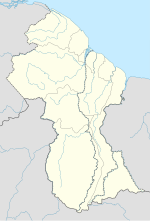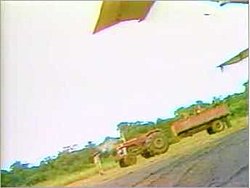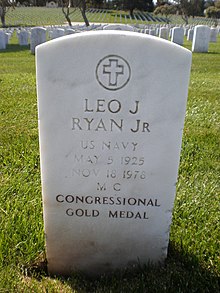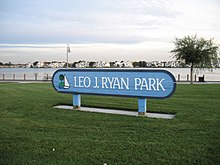| Representative Leo Ryan | |
|---|---|

Ryan c. 1977–1978
| |
| Member of the U.S. House of Representatives from California's 11th district | |
| In office January 3, 1973 – November 18, 1978 | |
| Preceded by | Pete McCloskey |
| Succeeded by | William Royer |
| Member of the California State Assembly from the 27th district | |
| In office 1962–1972 | |
| Preceded by | Glenn E. Coolidge |
| Succeeded by | Lou Papan |
| Mayor of South San Francisco, California | |
| Personal details | |
| Born | Leo Joseph Ryan Jr. May 5, 1925 Lincoln, Nebraska, US |
| Died | November 18, 1978 (aged 53) Port Kaituma, Guyana |
| Resting place | Golden Gate National Cemetery, San Bruno, California |
| Political party | Democratic |
| Children | 5 |
| Alma mater | Bates College (V-12) Creighton University (B.A.)(M.S.) |
| Occupation | Politician |
| Military service | |
| Allegiance | |
| Service/branch | |
| Years of service | 1943–1946 |
After the Watts Riots of 1965, Assemblyman Ryan took a job as a substitute school teacher to investigate and document conditions in the area. In 1970, he decided to investigate the conditions of California prisons. While presiding as chairman of the Assembly committee that oversaw prison reform, he used a pseudonym to enter Folsom Prison as an inmate. During his time in Congress, Ryan traveled to Newfoundland to investigate the practice of seal hunting. He was also famous for vocal criticism of the lack of Congressional oversight of the Central Intelligence Agency (CIA), and authored the Hughes–Ryan Amendment, passed in 1974.
Ryan was shot and killed at an airstrip in Guyana in November 1978 while his party was attempting to escape a dangerous situation. He had traveled to Guyana to investigate claims that people were being held against their will at the Peoples Temple Jonestown settlement. Ryan was killed the same day of the mass suicide, which occurred just 11 days after he was re-elected for a fourth term. He was the second sitting member of the U.S. House of Representatives to have been assassinated in office, the first being James M. Hinds in 1868.[2][3] He was awarded the Congressional Gold Medal posthumously in 1983.
Contents
Early life and education
Ryan graduated from Nebraska's Creighton University with a B.A. in 1949 and an M.S. in 1951.[4] He served as a teacher, school administrator and South San Francisco city councilman from 1956 to 1962. He taught English at Capuchino High School, and chaperoned the marching band in 1961 to Washington, D.C., to participate in President John F. Kennedy's inaugural parade.[8] Ryan was inspired by Kennedy's call to service in his inaugural address, and decided to run for higher office.[9]
Career
Official Congressional photo from Ryan's first term as Congressman, 1973
State of California
In 1962, Ryan was elected mayor of South San Francisco. He served less than a year as mayor, before taking a seat in the California State Assembly's 27th district, winning his assembly race by a margin of 20,000 votes.[9][10] He had previously run for the State Assembly's 25th district in 1958, but lost to Republican Louis Francis.[10] Ryan served as a delegate to the Democratic National Convention in 1964 and 1968,[4] and he held his Assembly seat through 1972, when he was elected to the United States House of Representatives. He was successively elected three more times to the United States Congress.[4]U.S. Congresswoman and former California State Senator and Ryan aide Jackie Speier described Ryan's style of investigation as "experiential legislating".[9] After the Watts Riots of 1965, Assemblyman Ryan went to the area and took a job as a substitute school teacher to investigate and document conditions in the area. In 1970, using a pseudonym, Ryan had himself arrested, detained, and strip searched to investigate conditions in the California prison system. He stayed as an inmate for ten days in the Folsom Prison, while presiding as chairman on the Assembly committee that oversaw prison reform.[11][12]
As a California Assemblyman, Ryan also served as the Chairman of legislative subcommittee hearings and presided over hearings involving his later successor as Congressman, Tom Lantos.[13] Ryan pushed through important educational policies in California and authored what came to be known as the Ryan Act, which established an independent regulatory commission to monitor educational credentialing in the state.[14]
United States Congress
During his time in Congress, Ryan went to Newfoundland with James Jeffords to investigate the inhumane killing of seals,[15][16] and he was famous for vocal criticism of the lack of Congressional oversight of the Central Intelligence Agency (CIA), authoring the Hughes–Ryan Amendment,[17][18] which would have required extensive CIA notification of Congress about planned covert operations.[19][20] Congressman Ryan once told Dick Cheney that leaking a state secret was an appropriate way for a member of Congress to block an "ill-conceived operation".[21] Ryan supported Patricia Hearst, and along with Senator S. I. Hayakawa, delivered Hearst's application for a presidential commutation to the Pardon Attorney.[22]Peoples Temple
In 1978, reports regarding widespread abuse and human rights violations in Jonestown among the Peoples Temple, led by cult leader Jim Jones, began to filter out of the organization's Guyana enclaves. Ryan was friends with the father of former Temple Member Bob Houston, whose mutilated body was found near train tracks on October 5, 1976, three days after a taped telephone conversation with Houston's ex-wife in which leaving the Temple was discussed.[23] Ryan's interest was further aroused by the custody battle between the leader of a "Concerned Relatives" group, Timothy Stoen, and Jones following a Congressional "white paper" written by Stoen detailing the events.[24][25] Ryan was one of 91 Congressmen to write Guyanese Prime Minister Forbes Burnham on Stoen's behalf.[23][24]Later, after reading an article in the San Francisco Examiner, Ryan declared his intention to go to Jonestown, an agricultural commune in Guyana where Jim Jones and roughly 1,000 Temple members resided. Ryan's choice was also influenced both by the Concerned Relatives group, which consisted primarily of Californians, as were most Temple members, and by his own characteristic distaste for social injustice.[26] According to the San Francisco Chronicle, while investigating the events, the United States Department of State "repeatedly stonewalled Ryan's attempts to find out what was going on in Jonestown", and told him that "everything was fine".[9]
The State Department characterized possible action by the United States government in Guyana against Jonestown as creating a potential "legal controversy", but Ryan at least partially rejected this viewpoint.[27] In a later article in The Chronicle, Ryan was described as having "bucked the local Democratic establishment and the Jimmy Carter administration's State Department" in order to prepare for his own investigation.[12]
Travels to Jonestown
On November 1, 1978, Ryan announced that he would visit Jonestown.[28] He did so as part of a government investigation and received permission and government funds to do so.[29] He made the journey in his role as chairman of a congressional subcommittee with jurisdiction over US citizens living in foreign countries. He asked the other members of his Bay Area congressional delegation to join him on the investigation to Jonestown, but they all declined his invitation.[9] Ryan had also asked his friend, Indiana Congressman and future Vice President Dan Quayle, to accompany him – Quayle had served with Ryan on the Government Operations Committee – but Quayle was unable to go on the trip.[30]While the party was initially planned to consist of only a few members of the Congressman's staff and press as part of the congressional delegation, once the media learned of the trip the entourage ballooned to include, among others, concerned relatives of Temple members. Congressman Ryan traveled to Jonestown with 17 Bay Area relatives of Peoples Temple members, several newspaper reporters and an NBC TV team.[31] When the legal counsel for Jones attempted to impose several restrictive conditions on the visit, Ryan responded that he would be traveling to Jonestown whether Jones permitted it or not. Ryan's stated position was that a "settlement deep in the bush might be reasonably run on authoritarian lines".[31] However, residents of the settlement must be allowed to come and go as they pleased. He further asserted that if the situation had become "a gulag", he would do everything he could to "free the captives".[31]
Jungle ambush and assassination
On November 14, according to the Foreign Affairs Committee report,[32] Ryan left Washington and arrived in Georgetown, the capital of Guyana located 150 miles (240 km) away from Jonestown, with his congressional delegation of government officials, media representatives and some members of the "Concerned Relatives".[33]
Jonestown, Guyana.
While in Georgetown, Ryan visited the Temple's Georgetown headquarters in the suburb of Lamaha Gardens.[36] Ryan asked to speak to Jones by radio. Sharon Amos, the highest-ranking Temple member present, told Ryan that he could not because his present visit was unscheduled.[33] On November 17, Ryan's aide Jackie Speier (who became a Congresswoman in April 2008), the United States embassy Deputy Chief of Mission Richard Dwyer, a Guyanese Ministry of Information officer, nine journalists, and four Concerned Relatives representatives of the delegation boarded a small plane for the flight to an airfield at Port Kaituma a few miles outside of Jonestown.[32]
At first, only the Temple legal counsel was allowed off the plane, but eventually the entire entourage (including Gordon Lindsay, reporting for NBC) was allowed in. Initially, the welcome at Jonestown was warm,[29] but Temple member Vernon Gosney handed a note to NBC correspondent Don Harris (mistaking him for Ryan) which read "Please help me get out of Jonestown," listing himself and Temple member Monica Bagby.[31]
That night, the media and the delegation were returned to the airfield for accommodations following Jones's refusal to allow them to stay the night. The rest of the group remained.[32] The next morning, Ryan, Speier, and Dwyer all continued their interviews, and in the morning met a woman who secretly expressed her wish to leave Jonestown with her family and another family. Around 11:00 a.m. local time, the media and the delegation returned and took part in interviewing Peoples Temple members. Around 3:00 p.m., 14 Temple defectors, and Larry Layton posing as a defector, boarded a truck and were taken to the airstrip, with Ryan wishing to stay another night to assist any others who wished to leave. Shortly thereafter, a knife attack on Congressman Ryan failed while he was arbitrating a family dispute on leaving.[37] Against Ryan's protests, Deputy Chief of Mission Dwyer ordered Ryan to leave, but he promised to return later to address the dispute.[32]
Camera-shot by Bob Brown (NBC) of shooters
Concurrently, several other Peoples Temple members who had escorted the group out began to open fire on the transport plane, killing Congressman Ryan, three journalists and a defecting Temple member, while wounding nine others, including Speier.[23][38] The gunmen riddled Congressman Ryan's body with bullets before shooting him in the face.[39] The passengers on the Cessna subdued Larry Layton and the surviving people on both planes fled into nearby fields during and after the attack.[32]
That afternoon, before the news became public, the wife of Ryan's aide, William Holsinger, received three threatening phone calls. The caller allegedly stated, "Tell your husband that his meal ticket just had his brains blown out, and he better be careful." The Holsingers then fled to Lake Tahoe and later to a ranch in Houston. They never returned to San Francisco.[40]
Following its takeoff, the Cessna radioed in a report of the attack, and the U.S. Ambassador, John R. Burke, went to the residence of Prime Minister Forbes Burnham.[32] It was not until the next morning that the Guyanese army could cut through the jungle and reach Jonestown.[32] They discovered 909 of its inhabitants dead. They died in what the United States House of Representatives described as a "mass suicide/murder ritual".[32]
Conviction of Larry Layton
Larry Layton, brother of author and former Peoples Temple member Deborah Layton, was convicted in 1986 of conspiracy in the murder of Leo Ryan.[41] Temple defectors boarding the truck to Port Kaituma warned about Larry Layton that "there's no way he's a defector. He's too close to Jones."[42] Layton was the only former Peoples Temple member to be tried in the United States for criminal acts relating to the murders at Jonestown.[43][44] He was convicted on four different murder-related counts.[45]On March 3, 1987, Layton was sentenced to concurrent sentences of life in prison for "aiding and abetting the murder of Congressman Leo Ryan", "conspiracy to murder an internationally protected person, Richard Dwyer, Deputy Chief of Mission for the United States in the Republic of Guyana", as well as 15 years in prison on other related counts.[46] At that time, he was eligible for parole in five years.[47] On June 3, 1987, Layton's motion to set aside the conviction "on the ground that he was denied the effective assistance of counsel during his second trial" was denied by the United States District Court of the Northern District of California.[47] After spending 18 years in prison, Layton was released from custody in April 2002.[48]
Memorial
In honor of Leo Ryan, Veterans for Peace Chapter 124 was named after him. VFP 124 Leo J. Ryan Memorial.Burial
Ryan's headstone
Legacy and honors
- In 1983, Ryan was posthumously awarded a Congressional Gold Medal by the United States Congress, as the only member of Congress killed while in the line of duty; the bill was signed by President Ronald Reagan.[51][52] In President Reagan's remarks about the medal, he said: "It was typical of Leo Ryan's concern for his constituents that he would investigate personally the rumors of mistreatment in Jonestown that reportedly affected so many from his district."[51] Ryan's daughters Patricia and Erin had helped to garner support for the Congressional Gold Medal, in time for the fifth anniversary of Ryan's death.[53]
- In 1984, the National Archives and Records Center in San Bruno, California was named the Leo J. Ryan Federal Building in his honor, through a Congressional bill passed unanimously and signed by President Reagan.[54]
- Jackie Speier, Ryan's former aide, was elected in 1998 to the California State Senate. In 2008 she won a special election to the US Congress from California's 12th congressional district, much of it formerly Ryan's constituency.[55] After redistricting, since 2013 it has been designated as the state's 14th congressional district.
Daughters
Shannon Jo Ryan, Ryan's eldest daughter, joined the Rajneesh movement. After the Bhagwan moved to Oregon in 1981, she joined his commune, which became known as Rajneeshpuram.[29][56][57] Taking the name Ma Amrita Pritam, by December 1982 she had married another member, who also lived at the commune.[58]Patricia Ryan received her Masters in public administration from George Washington University in Washington, D.C., and later served (2001–12) until her retirement as executive director of the California Mental Health Directors Association (now the County Behavioral Health Directors Association of California). During the 1980s, she became involved as a volunteer and eventually served as president of the board of the national Cult Awareness Network.[59][60][self-published source]
Erin Ryan went to University of California's Hastings School of Law, afterward working until 1992 as an intelligence analyst for the Central Intelligence Agency. She next worked in New York as a pastry chef for eight years. In 2000, Erin Ryan joined California Senator Jackie Speier in politics, working as her aide.[59]
Anniversaries
Sign at the Leo J. Ryan Memorial Park
Leo J. Ryan Post Office Building
Near the end of the memorial service, parents of those who had died in Jonestown stood to honor and thank Congressman Ryan for giving his life while trying to save their children. After the service ended, mounted police escorted the family and friends into Foster City's Leo J. Ryan Memorial Park. A wreath was laid next to a commemorative rock that honors Ryan.[61]
The same year, his daughter Erin Ryan, an aide to Speier, attended a memorial for those who died at Jonestown, held at the Evergreen Cemetery in Oakland.[62] On the anniversary of Congressman Ryan's death, Jackie Speier and Patricia Ryan, his daughter and friend, visit his grave at the Golden Gate National Cemetery.[31]
For the 30th anniversary, US Congresswoman Jackie Speier sponsored a bill to designate the United States Postal Service facility at 210 South Ellsworth Avenue in San Mateo, California, as the "Leo J. Ryan Post Office Building".[63] President George W. Bush signed it into law on October 21, 2008.[64] On November 17, 2008, Jackie Speier spoke at the dedication ceremony at the post office. In part, she said,
There are those – still, thirty years after his passing – who question his motives, or the wisdom of his actions. But criticism was just fine with Leo. Leo Ryan never did anything because he thought it would make him popular. He was more interested in doing what he knew was right.[65]
In popular culture
Ryan has been portrayed in films about the Jonestown mass murder/suicide, including by actor Gene Barry in the 1979 film Guyana: Crime of the Century,[66] and by Ned Beatty in the 1980 made-for-TV miniseries, Guyana Tragedy: The Story of Jim Jones.[67]His assassination was discussed in the documentaries Jonestown: The Life and Death of Peoples Temple (2006),[68] on The History Channel documentaries: Cults: Dangerous Devotion[69] and Jonestown: Paradise Lost (2006),[70] as well as the MSNBC production, Witness to Jonestown (2008), which aired on the 30th anniversary of Ryan's assassination and the mass suicides at Jonestown.[71]
Electoral history
Source[10]
|
|
Published works
- Books
- USA/From Where We Stand: Readings in Contemporary American Problems, Paperback book, Fearon Publishers, (1970)
- Understanding California Government and Politics, 152 pages, Fearon Publishers, (1966)
- Congressional reports
- NATO, pressures from the southern tier: Report of a study mission to Europe, August 5–27, 1975, pursuant to H. Res. 315, 22 pages, Published by United States Government Print Office, (1975)
- Vietnam and Korea: Human rights and U.S. assistance : a study mission report of the Committee on Foreign Affairs, U.S. House of Representatives, 15 pages, Published by United States Government Print Office, (1975)
- The United States oil shortage and the Arab-Israeli conflict: Report of a study mission to the Middle East from October 22 to November 3, 1973, 76 pages, Published by United States Government Print Office, (1973)
See also
- Leo J. Ryan Federal Building
- Destructive cult
- Seductive Poison
- List of assassinated American politicians
- United States Congress members killed or wounded in office
- List of United States Congress members who died in office (1950–99)
Notes
References
- Ryan, Leo J. (1966). "Understanding California Government and Politics". Palo Alto, CA: Fearon Publishers.
- Hall, John R. (1987). Gone from the Promised Land: Jonestown in American Cultural History. New Brunswick, New Jersey: Transaction Publishers. ISBN 0-88738-124-3.
- Reiterman, Tim; Jacobs, John (1982). Raven: The Untold Story of Rev. Jim Jones and His People. Dutton. ISBN 0-525-24136-1.
Further reading
- Biography, Biographical Directory of the United States Congress
- Congressional Gold Medal, Text of the act issuing the Congressional Gold Medal and an FBI report summary as well as an article on both Jones and his involvement and the investigation
- On the 25th anniversary of the Jonestown Massacre and Ryan's assassination at the Wayback Machine (archived June 27, 2007), 2003, Press release from Rep. Tom Lantos, California 12th Congressional District
External links
- JoinCalifornia, Election History for the State of California
- Congressman Leo J Ryan Memorial Page, hosted by Arnaldo Lerma
- Leo J Ryan Memorial park in Foster City, California
- Leo Ryan at Find a Grave
| Political offices | ||
|---|---|---|
| Preceded by Unknown |
Councilman, South San Francisco, California 1956–1962 |
Succeeded by Unknown |
| Preceded by Unknown |
Mayor of South San Francisco, California 1962 |
Succeeded by Unknown |
| California Assembly | ||
| Preceded by Glenn E. Coolidge |
Member of the California State Assembly 1962–1972 |
Succeeded by Lou Papan |
| U.S. House of Representatives | ||
| Preceded by Paul N. McCloskey, Jr. |
Member of the U.S. House of Representatives from California's 11th congressional district 1973–1978 |
Succeeded by William H. Royer |
Categories:
- Leo Ryan
- 1925 births
- 1978 deaths
- American Roman Catholics
- American naval personnel of World War II
- American people murdered abroad
- American people of Irish descent
- Assassinated American politicians
- Bates College alumni
- California Democrats
- Congressional Gold Medal recipients
- Creighton University alumni
- Critics of Scientology
- Critics of the Unification Church
- Deaths by firearm in Guyana
- Filmed assassinations
- Mayors of places in California
- Members of the California State Assembly
- Members of the United States House of Representatives from California
- People murdered in Guyana
- Politicians from Lincoln, Nebraska
- Peoples Temple
- United States Navy officers
- Democratic Party members of the United States House of Representatives
- Burials at Golden Gate National Cemetery
- 20th-century American politicians
- Catholics from Nebraska
Languages
Ryan is the only member of Congress to have been killed in the line of duty and was posthumously recognized in the 1980s with a congressional award presented by then-President Ronald Reagan.


















No comments:
Post a Comment